Becoming Bishan: Heritage Exhibition
2Update: For the latest on which library the exhibition has moved to please click on this FB page link
Becoming Bishan: A Heritage Exhibition
What is Bishan? A concrete jungle of million-dollar HDB flats? The futuristic, award-winning architecture of SkyHabitat and Bishan Library? Or even the bustling activity of Junction 8? These are the conventional perceptions of the young, vibrant town of Bishan – an ex-cemetery transformed into a heartland showpiece.
Our team, however, felt that there just had to be more to this rising area. Whether we were lifelong residents of the district or saw it as a mere part of our daily commute to school, we became increasingly curious about how this place came to be. Why was there even a cemetery in Bishan in the first place? Did people live in Bishan before the HDB flats were built? What was Bishan’s place in the Singapore Story?
Driven by overwhelming curiosity, we, in conjunction with the Raffles Archives and Museum, embarked upon the Becoming Bishan Project, hoping that the outcomes of our research would be able to provide a poignant contribution to our country’s jubilee celebrations.
Our first step was to analyse the development of Bishan through maps. One of our members, Yilun, is an avid map enthusiast with an especial interest in urban redevelopment. With gusto, he surfaced many old maps of the area, the oldest dating back to 1924. Through painstaking effort, he managed to highlight the stark changes in the landscape of the area, as well as match old landmarks of the area to more familiar present-day ones. The topographical studies revealed many details about the geography of the Bishan area. Today, the land that makes up Bishan is rather flat. However, the contours of old maps suggest that pre-redevelopment,
Bishan was covered by rolling hills. Many photographs also show the grave-covered hills with the HDB flats of Toa Payoh in the background. This explains the how the name “Bishan” (“Jade Hills” in Mandarin) came about. One of our interviewees even compared the view from a Toa Payoh flat to a green dragon, because of the undulating hills and the scale-like tombs on them.
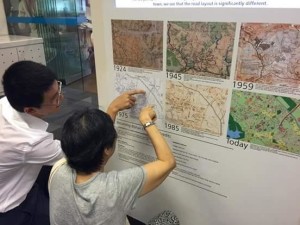
The highlight is a series of maps of Bishan tracing the landscape of changes from 1924 to the present (Photo RI Student Project Team)
There were several kampongs within the cemetery, the most notable one being Kampong San Teng, whose kampong association members still meet regularly today. Interviews with the old residents revealed a rather self-sufficient community, with a school, farms, a teahouse and a market. There was also a cinema, Nam Kok cinema, in the Bishan area that screened Chinese and Western films. A worker in the KPT coffee shop in Bishan North told us of how he used to work there, proudly showing us his old posters of Elvis Presley and actors from Hong Kong. But when we asked about people’s impressions of Bishan before redevelopment, the greatest fears were not ghosts and spirits, but secret society activity.
We also made several exciting discoveries along our research journey. One was that Bishan was once a World War II battlesite! Jon Cooper, who also runs the Bukit Brown battlefield tours, managed to surface the battalion diaries and hand-drawn maps of the Second Cambridgeshire Regiment. These documented the action at Braddell Road in the dying days of the Battle for Singapore (1942). Further research revealed that the battle positions occupied by the British troops are the present-day locations of Junction 8 shopping mall, Bishan Library and Raffles Institution. This story was corroborated by many residents, who recalled the sounds of gunfire through the rolling hills of Bishan. Another revelation we made was that the philanthropist Wong Ah Fook was once buried in the Peck San Theng cemetery and his ashes now lie in the columbarium, something that even those running the columbarium had been unaware of.
Along the way, our team has also met and befriended many diverse characters, who each have their own personal stake in Bishan. From the intriguing Mr. Molay, a Cantonese-speaking Indian man whose father once owned a hundred cows in Bishan, to the unabashed Mr. Loh, who once ate human flesh to survive the deprivation of the Japanese Occupation, it is the stories of these people who make the Bishan Story come alive. We thoroughly enjoyed the opportunity to talk to these individuals and learn more about the almost-foreign land that is the past. Later, we also spoke to current residents who told us about their thoughts and memories about this place. Though it is hard to say that the HDB dwellers of today have the same community spirit as kampong residents did, it was interesting to note how people develop, or fail to develop, attachments to Bishan.
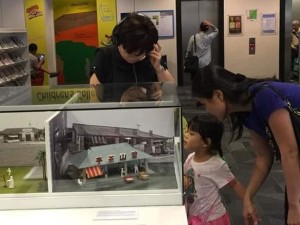
Visitors to the exhibition have a chance to listen in on their memories of Bishan as a cemetery and its social community life then (photo RI Project Team)n
We feel immensely privileged to have had the experience of exploring Bishan’s story and curating this exhibition, and hope that you might find meaning of your own in our fruits of labour and love.
The Becoming Bishan exhibition will be officially launched on 11 July (Saturday), from 9 am – 12 noon, at the Bishan Community Library. This event will be graced by Senior Minister of State Josephine Teo. The exhibition will run at the Bishan Community Library from 1 July to 23 August, Ang Mo Kio Public Library from 24 August to 30 September and Toa Payoh Public Library from 1 to 31 October.
This is a student project from Raffles Institution, as part of the South cluster schools’ contribution to the SG50 celebration efforts.
This blog post is a team contribution from the students of Raffles Institution involved in Becoming Bishan.
atBB reviews:
atBB visited the exhibition and we are struck by the sheer breath of the history and heritage the students have been able to uncover of Bishan and how it has evolved into what it is today. From the old to the modern, the curated posters capture more than a snap shot, but with carefully chosen quotes, it has emotional resonance such that, one can be transported to a different time and space in Singapore.
Of particular interest was the coverage on how the community coped with WW 2 and provided refuge for other residents in other areas in war torn Singapore.
The exhibits on WW II was an eye opener with artefacts from both Japanese and British sides.
Augmented with video recordings of residents interviewed makes this exhibition a exemplar template for exhibitions on other neighbourhoods to emulate. Accompanying the exhibition is a pictorial booklet which value adds the exhibition and makes for a treasured keep sake for those interested in history and heritage and the transition to the modern.
atBB has been following the development of this project since the students first approached us for help in understanding cemetery culture and symbolism. We are proud to have made a small contribution to this project and have to say that full credit go to the students for taking it so far from when they first began. Congratulations and well done!
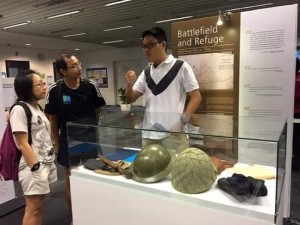
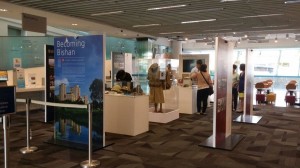
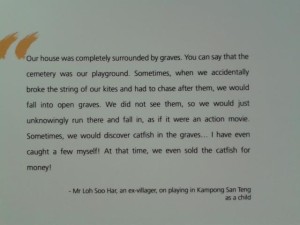
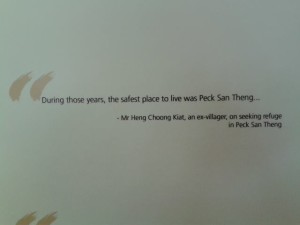
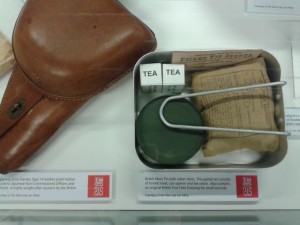
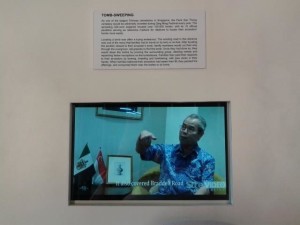
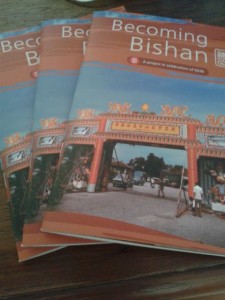

The dates and locations of the Becoming Bishan exhibition are outdated. Please check the event Facebook page and update this article accordingly ASAP to prevent further misunderstanding. Thanks.
Thanks, Yiyang. We are all volunteers so updating is sometimes a challenge. I will look for the link and update the article on top with the link.